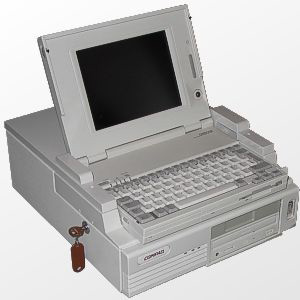Compaq LTE Lite
For a long time, myhands itchedto write about the car that had attached me to the PC world, but it didn’t get enough time, especially since the computer had been lying in the garage of the parents for several years, and it wasn’t so close to them. But a number of articles lately on Habré about the old hardware did provoke me to remove the computer from the garage and try to start it.
Yes, since it is not only an old hardware, but also a laptop, and in a compartment with a docking station it is also a desktop computer, I also put the article in these hubs. Correct, if not right.
So, it will be about Compaq LTE Lite 4/25 C. It should have looked like the one shown on the left. In this case, the laptop is inserted in the docking station, but the external monitor, keyboard and mouse are not used.
Prehistory
Sometime back in 1996, thanks to a miraculous coincidence of circumstances, this handsome man (see photo above) got into our family in a complete set, but without an external monitor. It was produced in 1993. The assembly, judging by the labels, is Canadian. Those who were interested in computers in the 90s, will understand my pride in this device after I announce the characteristics. In addition to the laptop itself, there is a docking station that turned the compact laptop into a full-fledged workstation.
So:
* A laptop:
- Intel 486DX 25 MHz processor;
- LCD screen 8 '', VGA 640x480 256 colors;
- 12 MB of RAM (4 on the motherboard and 8 on the bar the size of a plastic credit card);
- NMH battery with a capacity of 2.2 Ah;
- 200 MB HDD;
- floppy 1.44 MB;
- expansion slot;
* Dock station:
- two 16-bit ISA standard expansion slots;
- two compartments for floppy or HDD;
- the ability to connect an external monitor, keyboard, mouse, printer;
- the design allowed to install an external monitor on top of the docking station;
- theoretically, it was possible to connect two HDDs and one floppy disk, on this instance one external HDD with a capacity of 200 MB was installed, there was no external drive.
In addition, our Compaq (docking station) was equipped with an expansion card for a handheld scanner, and the Logitech scanner itself was also present. Although it was difficult to get a normal scan from him without dexterity, but in 1996, and even in the village, such equipment was incredibly cool. I immediately abandoned my Spectrum and began to study new hardware and software.
System software consisted of MS DOS 5.0, edited by Compaq. Also present was Windows 3.1. It was all in German. Looking ahead, I’ll say that I was later able to successfully install PC DOS 7.0 and Windows 95. An external single-speed CD-ROM drive that works via an LPT port also appeared later, but I hope I’ll tell you about it in the next section. And if there is a scanner, then about the scanner.
Years passed, the equipment worked fine. But at one point, the cable connecting the screen and the motherboard burst at the bend. I decided to reconnect using wiring in enamel insulation. And at first it all worked, but then one careless movement, a closure, and the screen stopped showing signs of life. I had to buy an external monitor. I disconnected the display for repair, and then it was lost somewhere. In time, the internal hard began to fail, then the floppy failed. Pieces carried to the garage.
This was the back story.
')
Actually, the story began last weekend when I came to my parents and the first thing I asked my brother to help me find iron.
Almost all the bolts in Lte Lite under a special star-shaped screwdriver, with two calibers. Fortunately, we have two branded screwdrivers for these bolts.

We begin to disassemble.
Immediately I apologize for the quality of the photos, perhaps there were ways to get better results.
Photos of what we found
Dock with cover removed

The case itself is made of at least 2 mm metal sheet. Plastic monitor cover with multiple stiffening ribs. This is understandable: it is necessary to withstand the weight of a heavy CRT monitor.
At the top left under the plastic board on which the ports are soldered and, as far as I understand, the main logic. The ports are as follows: two PS / 2 (mouse, keyboard), COM, LPT, VGA. Also present are the power connector and the external drive letter switch. It is necessary in order to be able to boot from an external drive. Top right of the power supply with a fan. At the bottom right there are two 5.25 slots for disk drives or HDD.
Removed the lid BP. The fan is a bit dusty, but manually spins up like new. As if he was not 20 years old and had not had several years of idle time in an unheated garage.
Left view.

Under the card with external ports is a card with expansion slots. At the top in the center is a connector for connecting a laptop. Under it and to the right below are contacts for power supply to the HDD, a cable for a floppy. Next to the top ISA connector is a DIP switch for configuring external drives.

The case itself is made of at least 2 mm metal sheet. Plastic monitor cover with multiple stiffening ribs. This is understandable: it is necessary to withstand the weight of a heavy CRT monitor.
At the top left under the plastic board on which the ports are soldered and, as far as I understand, the main logic. The ports are as follows: two PS / 2 (mouse, keyboard), COM, LPT, VGA. Also present are the power connector and the external drive letter switch. It is necessary in order to be able to boot from an external drive. Top right of the power supply with a fan. At the bottom right there are two 5.25 slots for disk drives or HDD.
Removed the lid BP. The fan is a bit dusty, but manually spins up like new. As if he was not 20 years old and had not had several years of idle time in an unheated garage.
Left view.

Under the card with external ports is a card with expansion slots. At the top in the center is a connector for connecting a laptop. Under it and to the right below are contacts for power supply to the HDD, a cable for a floppy. Next to the top ISA connector is a DIP switch for configuring external drives.
In the docking station itself, nothing is already installed. We look at the smallest HDD we have. We find on 20 GB. A lot, but nothing remains. Install.
Then came the turn of the laptop itself. Now it looks like this:

Left battery. Now it plays the role of an aesthetic only. Although in the mid-90s I kept, if I am not mistaken, more than an hour in the mode of working with text. Keyboard with German layout. Clearly visible pasted Cyrillic letters. Cover-display, as I mentioned, is missing.
Visa from behind. Abundance of interfaces. It is a pity the current laptops are deprived of such luxury. From left to right: COM, LPT, VGA, docking station connection, PS / 2, power supply.

We disassemble the laptop. A photo.
The lid, which is around the keyboard, on the latches, for their release, there is a special tool that must be inserted between the lid and the case, pressing down on the latches.
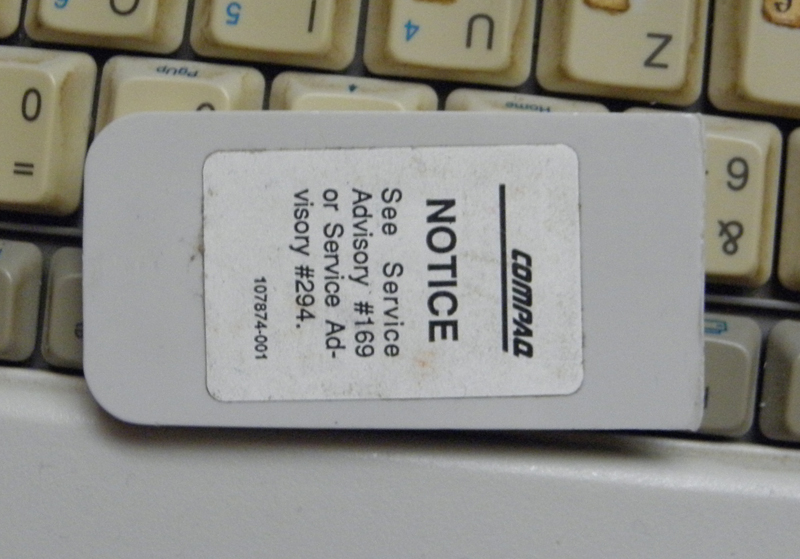
Even with such a tool to remove the cover is not so easy. But the cover is removed.
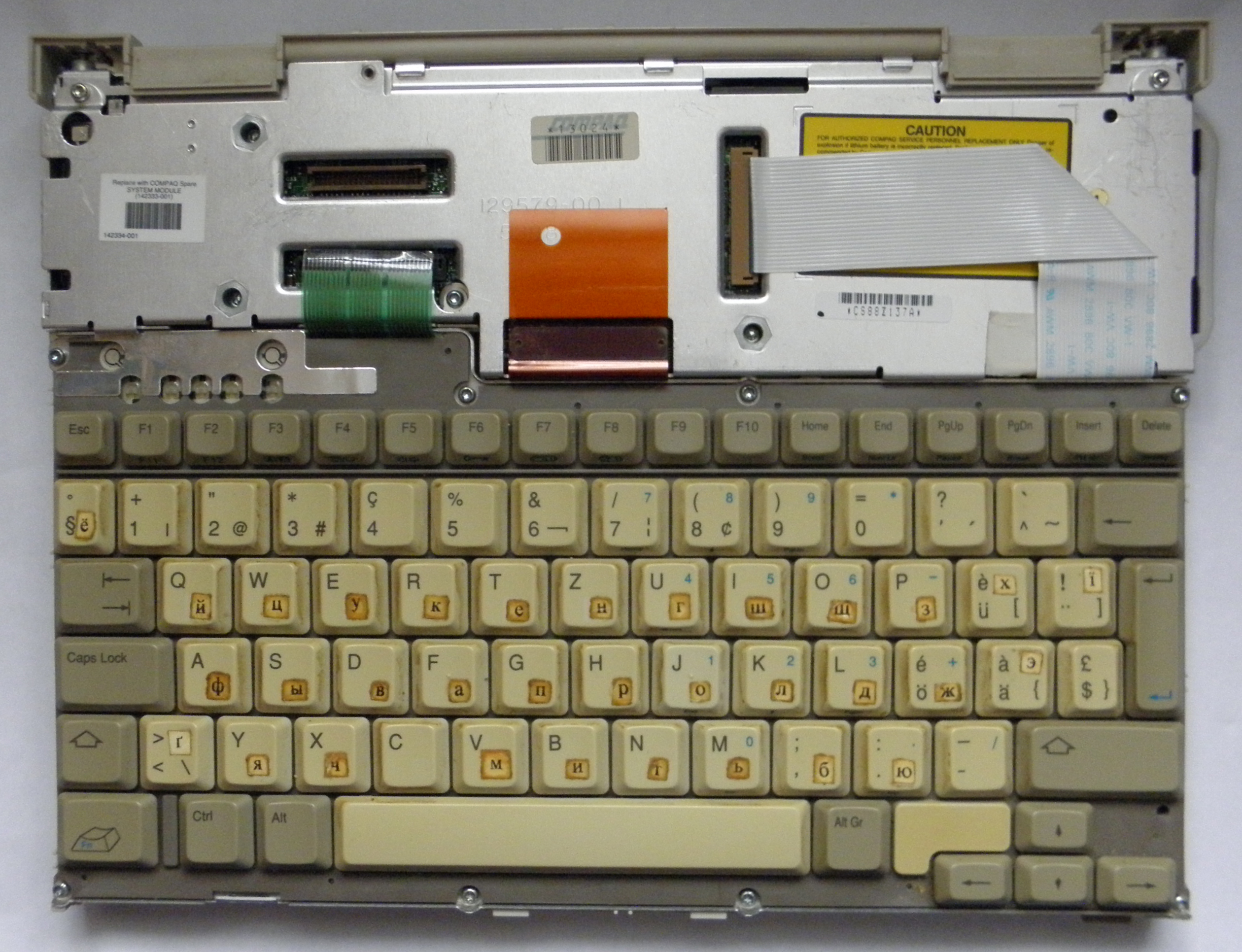
At the top left is a brown connector for the display plume. So far, nothing interesting.
We analyze further

Already more interesting. Left empty space - the battery compartment. In the middle of the hard drive. On the right is floppy.

HDD & FDD. The first maid in Singapore, the second in Japan. Both the first and second ordered to live long. But hard is not determined at all, and floppy tries to read, but without success. By the way, for this reader and writer on magnetic disks, the LED lights up red when double-density floppy disks are read (720 Kb, who do not know, HD) and green when 2HD (that is, twice in double density, 1.44 MB). And the usual density is 360 KB.
Remove the cover over the motherboard.
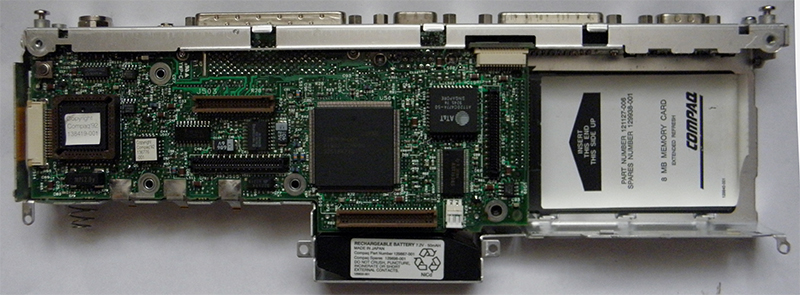
On the left, as I understand it, the BIOS. The purpose of the other chips is unknown to me. Bottom is a rechargeable battery with a voltage of 7.5 (it is also not clear why). Right 8MB memory card. The maximum you could put a card at 32 MB. The motherboard is two-story. Then I did not disassemble. But judging by how heated the metal cover, the processor on the left of the bottom board. No fans! Only hardcore, only natural convection.
Above the memory card there is free space in height. According to rumors, there it was possible to connect a modem at 14.4 Kbps. Which connector? I do not know. Can branded Compaq.
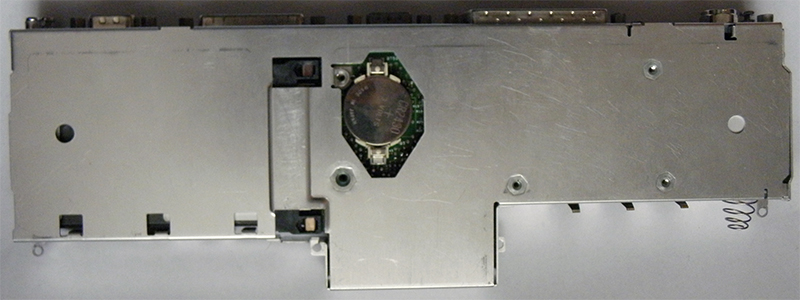
Bottom ordinary CMOS battery. Naturally long gone.
I collect everything back.

Even with such a tool to remove the cover is not so easy. But the cover is removed.

At the top left is a brown connector for the display plume. So far, nothing interesting.
We analyze further

Already more interesting. Left empty space - the battery compartment. In the middle of the hard drive. On the right is floppy.

HDD & FDD. The first maid in Singapore, the second in Japan. Both the first and second ordered to live long. But hard is not determined at all, and floppy tries to read, but without success. By the way, for this reader and writer on magnetic disks, the LED lights up red when double-density floppy disks are read (720 Kb, who do not know, HD) and green when 2HD (that is, twice in double density, 1.44 MB). And the usual density is 360 KB.
Remove the cover over the motherboard.

On the left, as I understand it, the BIOS. The purpose of the other chips is unknown to me. Bottom is a rechargeable battery with a voltage of 7.5 (it is also not clear why). Right 8MB memory card. The maximum you could put a card at 32 MB. The motherboard is two-story. Then I did not disassemble. But judging by how heated the metal cover, the processor on the left of the bottom board. No fans! Only hardcore, only natural convection.
Above the memory card there is free space in height. According to rumors, there it was possible to connect a modem at 14.4 Kbps. Which connector? I do not know. Can branded Compaq.

Bottom ordinary CMOS battery. Naturally long gone.
I collect everything back.
Now comes the fun part. I insert the laptop into the docking station. We connect the 19 '' monitor-TV to the VGA connector. It does not connect - there is no one of the holes in the docking station in the connector. On the cable all the legs. Break out. We connect. And, oh, a miracle! The screen came to life. F10 - in the BIOS. We set the date and time and go to the settings. BIOS translated into English, German, French and Spanish.
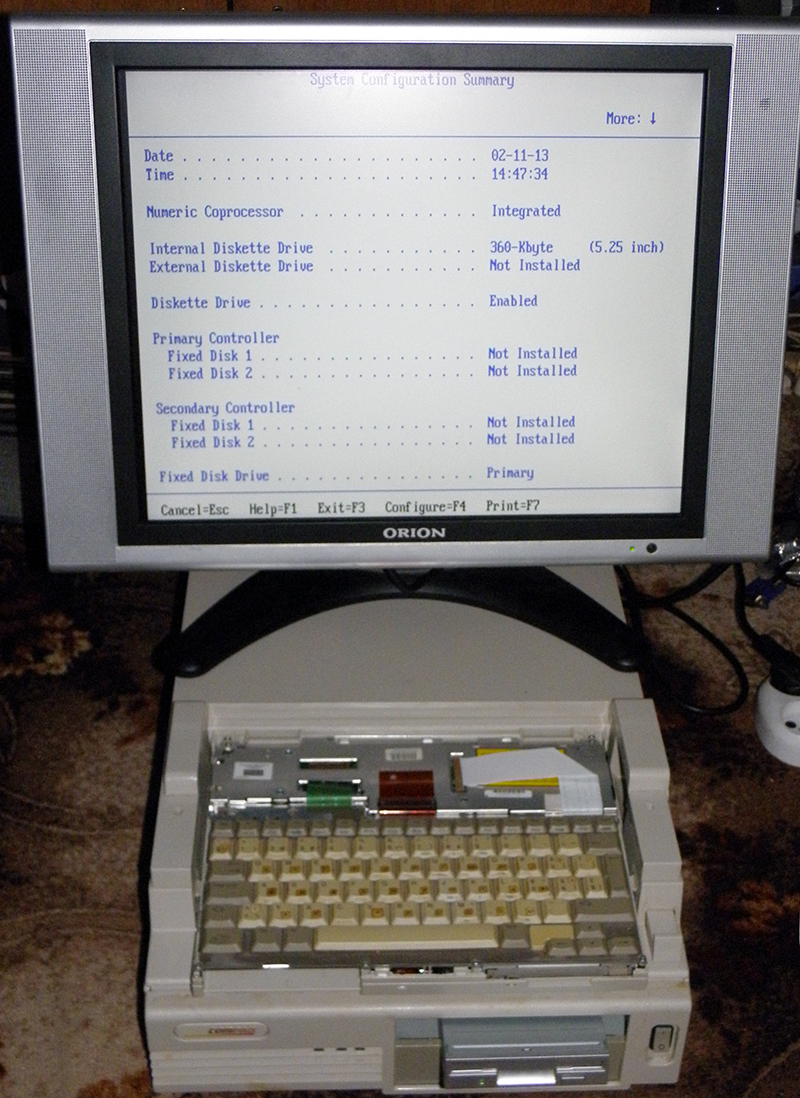
Variable parameters are smaller than in modern BIOS. You can change the frequency of the processor (from low to hight four gradations, maximum 25 MHz, minimum, if not mistaken, 12 (or 8?)); configure the time to go to sleep, turn off the disk screen; screen brightness; configure ports by assigning them interrupts; specify which HDD and FDD are installed, etc ...
More BIOS

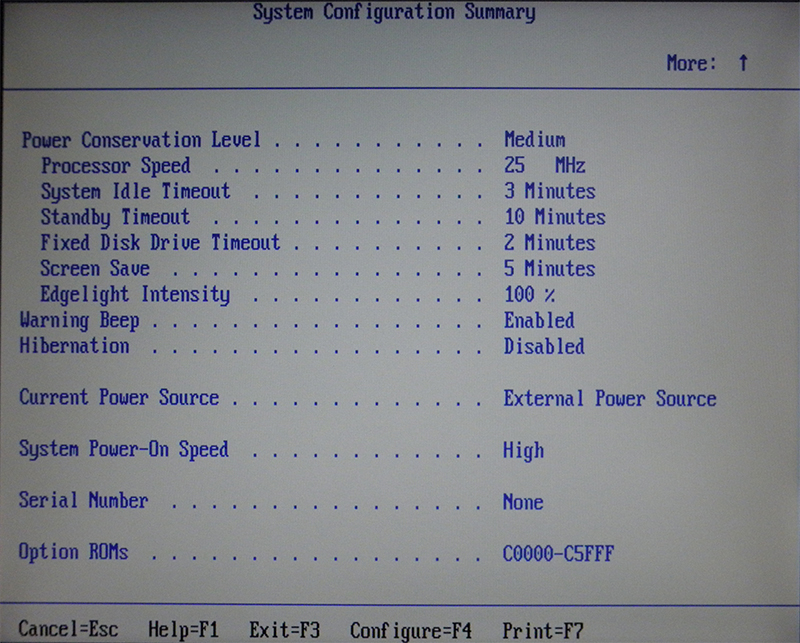

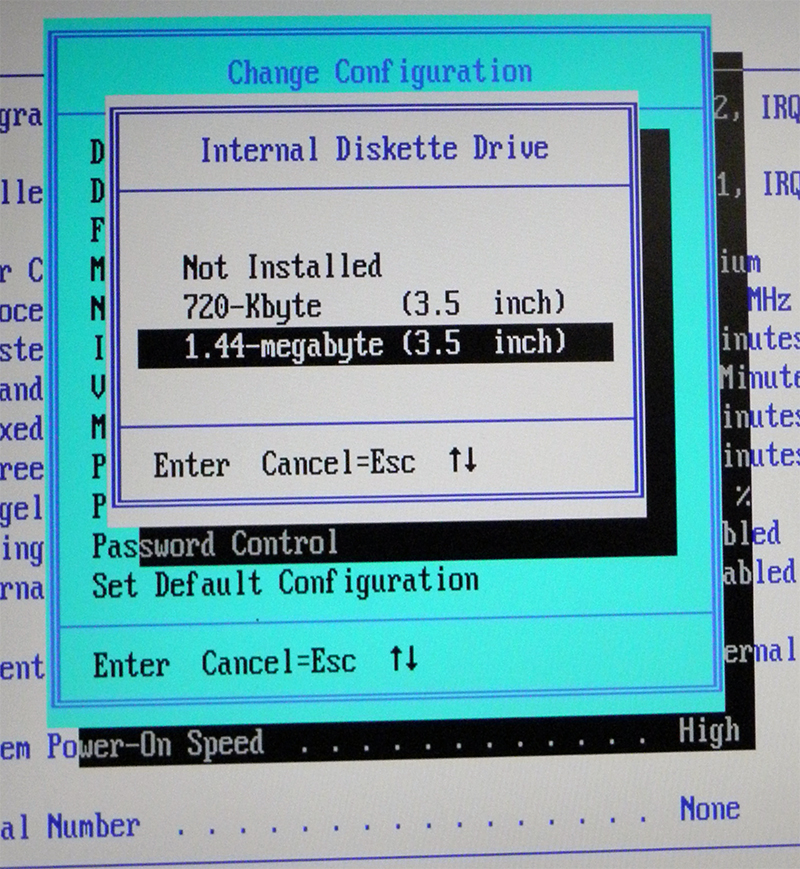




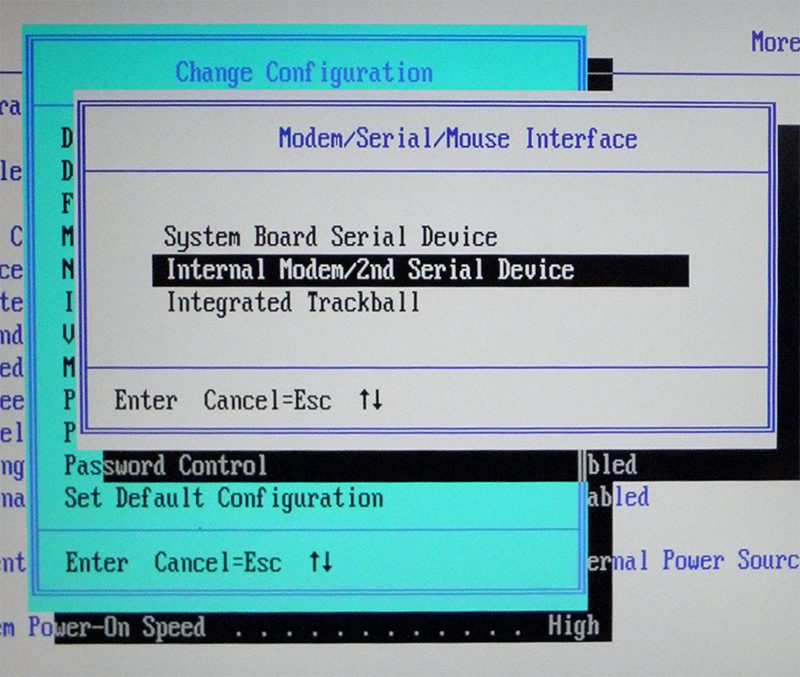










But you need at least a drive to boot. We try from the inside - puffs, puffs, tries to read diskettes in different modes - the LED is green, then red - but there are no results. We understand. We connect the external FDD to the docking station, the benefit is the corresponding loop. We connect - the indicator on the floppy is lit constantly. Loop the wrong side? I turn over. Does not burn, but does not read the diskette. They played, played (DIP'om on the docking station, setting the type of drive in BIOS) until the brother noticed that the cable on one side had twisted wires. Connecting the flop is not in the last slot, but in the middle.

On the docking station, set the disk "A", and, Oh! Miracle! drive comes to life when turned on.
But you need a boot floppy. I ask my brother to find DOS, remembering in parallel that his brother once started writing his own OS, but he quit. However, the loader and the command line work. Insert, load
and here it is: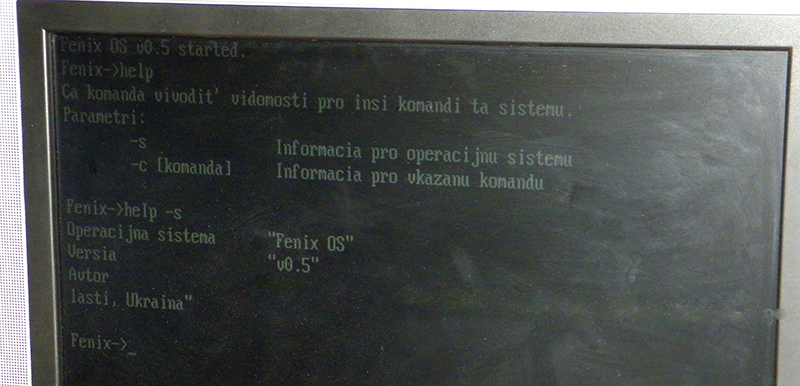

Write the DOS boot.
DOS, came out all under DOS ...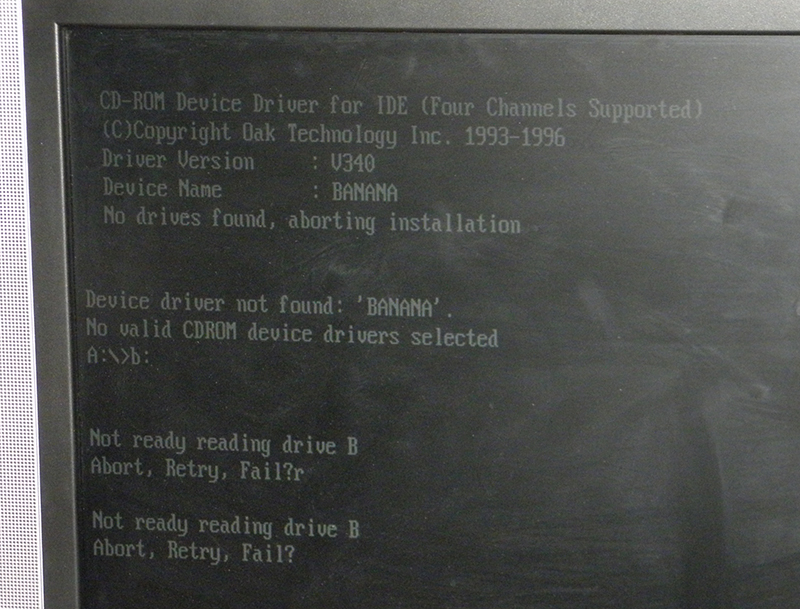

But the BIOS does not see the 20 GB screw installed in the docking station. In DIOS, you can only select from 61 pre-installed disk types, and you cannot specify your number of sectors, heads and cylinders. Accordingly, it does not see the disk and DOS. Output? Linux And between DOS and Linux, they tried to start KolibriOS, but even the earliest version caused a reboot of a 100% read diskette.
I had to download the boot + 5 Slackware 8.1 installation diskettes. ABOUT! It was not easy ... not easy to find 5 diskettes without bads. It took more than an hour. But we did that too! ;-)
And here's the result: the disk is visible. It has NTFS. I launch fdisk, sleight of hand and no fraud © Then mk2fs and the final image:

Then it did not go due to the fact that the installation requires a disk with packages. And for this you need to connect an IDE CD-ROM. And for this you need to first find it, and for this you need ... but the weekend has already ended.
If nothing hurts, then next time I’ll tell you about installing a CD-ROM and Linux. And if you're lucky, then about the external "sidyuk", and about the scanner. This is if there is a second one, and for the first there is a floppy disk with firewood.
PS And if I find suitable FDD, HDD for laptop, not to mention the screen, then I will tell you about Win 3.1, and about the animation on the screen of changing system settings, and about expansion cards :)
Source: https://habr.com/ru/post/200736/
All Articles
